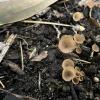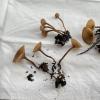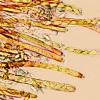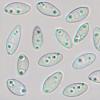
29-12-2025 08:30
Hello.A tiny ascomycete sprouting under Juniperus

29-12-2025 10:15
Hulda Caroline HolteHello, I found and collected this propoloid ascom

29-12-2025 09:38
Oskari VirtanenHi,could anyone help me identify this, I suspect P

28-12-2025 12:08
Margot en Geert VullingsThis possible Karstenia was found on the bark of d

21-12-2025 21:32
Pol DebaenstHello, Garden, Burgweg 19, Veurne, BelgiumOn 10/1

26-12-2025 21:19
Arnold BüschlenPithyella chalaudii Priou. Ist als Bryoparasit in

21-12-2025 09:32
Hello.A tiny ascomycete found embedded in wood in

18-12-2025 21:17
Pol DebaenstThe identification took me to Byssonectria deformi
Q = (1,6) 1,9 - 2,3 (2,7) ; N = 41
Me = 10,9 × 5,2 µm ; Qe = 2,1
Q = (15,8) 16,0 - 18,6 (20,9) ; N = 9
Me = 112,5 × 6,4 µm ; Qe = 17,6

De mémoire, il me semble que Ciborinia camelliae possède certains des caractères décrits
Amitiés Michel

Thanks for you answer !
Will get back in the greenhouse , they were a lot .
And do what you suggested.
Sébastien

Je dispose d une documentation assez complète
Michel


here's Hara's article and an approximate translation (google + deepl combined, but there are still some errors left and I don't the language to correct them).
Viktorie



Hara K (1919): A sclerotial disease of camelia (Camellia japonica). Dainippon Sanrin Kaiho 436: 29-31.
I don't know the researcher's first name - translators translated it as "Setsuke" but all mentioned papers cite "K. Hara".
The journal's archive is here: http://sanrin.sanrinkai.or.jp/
Saracchi et al cite another Kohn & Nagasawa article from 1984 in a japanese journal I haven't found yet: Kohn, L.M.; Nagasawa, E. A Taxonomic Reassessment of Sclerotinia camelliae Synonym Ciborinia camelliae with Observations on Flower Blight of Camellia japonica in Japan. Nippon. Kingakukai Kaiho 1984, 25, 149–162.


Some spécimens have been sent for sequencing to the museum of Paris , but it Will take a little while , usually they do ITS and LSU (28S) , will keep you posted !


"Shizuokaken Noukaiho 256, 10-11", "Dainippon Sanrin Kaiho 436, 29-31", "Nouji Shinpo 13(5), 17-18", "Engei no Tomo 15, 385-388".
All in Japanese and almost identical in content.
"Dainippon Sanrin Kaiho" was published on March 15, 1919, but "Shizuokaken Noukaiho" was published earlier, on February 25.
This paper is not mentioned in Kohn and Nagasawa, IF, or MyCoBank, but I believe it is the earliest paper validly published.
This paper contains specimen data not found in the other papers.
The "Shizuokaken Noukaiho 256" archived at:
https://agriknowledge.affrc.go.jp/RN/2039006141.pdf
Kutsuna

Automatic translation seems difficult.
According to Hara's description, specimen collected on Apr. 21, 1918, ascospores are 8-11 × 4-5.
Kutsuna





 On-the-sclerotinia-disease-of-camelia-Hara-1919--0001.pdf
On-the-sclerotinia-disease-of-camelia-Hara-1919--0001.pdf